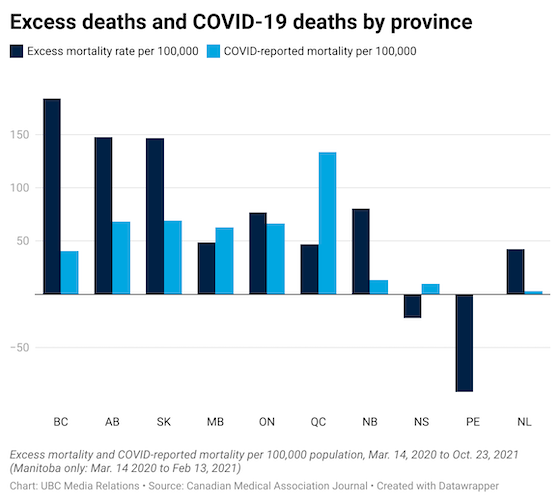Excess deaths in Canada during COVID-19 pandemic highest in the West
Pretend the COVID-19 pandemic never happened.
People still would have died across Canada, and the number of deaths would have been somewhat predictable based on data from previous years.
Dr. Kimberlyn McGrail, a professor in UBC’s School of Population and Public Health, examined all “excess deaths” across Canadian provinces during the first 19 months of the pandemic, and how many of those were attributed specifically to COVID-19.
Excess deaths are deaths above and beyond what would have been expected under normal circumstances.
Her findings were published on May 30 in the Canadian Medical Association Journal.
Why look at “excess deaths” rather than just COVID-19 deaths when trying to understand the pandemic?
The pandemic had a direct effect on deaths, in that people got the virus and unfortunately some died from it, but the pandemic also had other effects. People delayed care, or had surgeries, diagnostics, and appointments cancelled, which can lead to poorer outcomes. We also had other public health events going on—particularly in B.C. with the ongoing tainted drug supply and the heat dome in the summer of 2021. Those things were potentially affected by the pandemic. So overall mortality is a better indication of what’s actually happening at the population level.
How do we know how many deaths were expected?
I used data provided by Statistics Canada. They look at trends in the population’s size and age in the five years preceding the pandemic to model what would have been expected in 2020-21, absent the pandemic.
What did you learn about excess deaths across Canada during the pandemic?
Excess mortality is just an estimate, but the experience across the provinces, according to what Statistics Canada is telling us, is very different. We saw very little to no excess death in the Atlantic provinces, and quite high excess deaths in western provinces.

What are some possible explanations for this wide variation?
One of the challenges is that a number of different things could contribute to this variation, and it’s probably not one or another, but a combination.
For COVID-19 deaths, differences in COVID-19 reporting practices could be contributing. Each province defines and counts COVID-19 deaths in different ways, and reports them at different speeds.
For overall excess deaths, it could be because provinces differed in their responses to COVID-19. It could be because of the additional public health events going on. Or it could be the broader implications of COVID-19, like cancelled surgeries and delayed diagnostics. There may also be some inaccuracy in the modelling of expected deaths by Statistics Canada.
Your study shows that excess deaths far exceeded COVID-19 deaths in some provinces. How is that possible?
I'll use the heat dome in the summer of 2021 as a particular example. The B.C. Coroners Service has now attributed almost 600 deaths to that event. You might say that's not related to COVID-19. However, so much policy attention was being placed on COVID-19 at the time. Some of the precautions, with people being locked down, limited activity, and so on, might have contributed to how we responded to the heat dome, which in turn could have contributed to deaths. For example, lots of older people living alone didn’t have the usual level of social support and people checking on them.
What does this study reveal about the way data is collected and reported across provinces?
Probably the most important thing to underline is that good, timely data are essential for health care system planning. There has to be clear understanding of what the trends are and the most likely reasons for those trends so appropriate decisions can be made.
Given the variation in excess mortality across provinces, it's really important that we have a pan-Canadian conversation about trying to understand which potential causes are related to that, and come to some agreement about common data, timeliness and definitions. Clearly we're going to have health events and pandemic-type things happen again. This is the opportunity to have those conversations. That's how we’re going to make sure we're prepared for the next event.






























